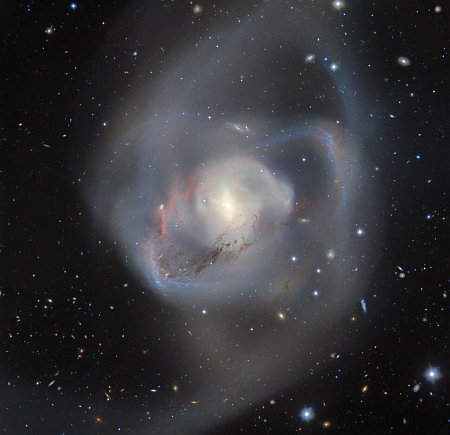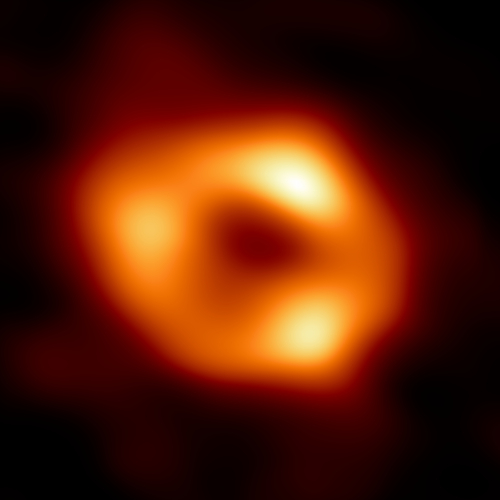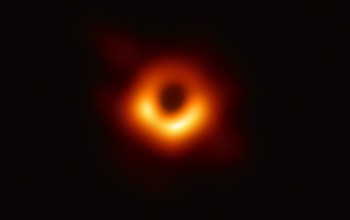Swirling galactic-sized streams surrounding a pair of supermassive black holes
Time for another galactic cool image! The picture to the right, reduced and sharpened to post here, was released today by the Gemini South ground-based telescope in Chile. It shows the streams of gas and stars that swirl around a pair of supermassive black holes at the center of this galaxy, located only 90 million light years away.
The image reveals vast swirling bands of interstellar dust and gas resembling freshly-spun cotton candy as they wrap around the merging cores of the progenitor galaxies. From the aftermath has emerged a scattered mix of active starburst regions and sedentary dust lanes encircling the system.
What is most noteworthy about NGC 7727 is undoubtedly its twin galactic nuclei, each of which houses a supermassive black hole, as confirmed by astronomers using the European Southern Observatory’s Very Large Telescope (VLT). Astronomers now surmise the galaxy originated as a pair of spiral galaxies that became embroiled in a celestial dance about one billion years ago. Stars and nebulae spilled out and were pulled back together at the mercy of the black holes’ gravitational tug-of-war until the irregular tangled knots we see here were created.
The black holes themselves are 154 and 6.3 million solar masses respectively, and are presently about 1,600 light years apart. Scientists calculate that they will merge in about 250 million years. Each once formed the center of its own galaxy. Now both galaxies have merged, creating this three-dimensional whirlpool of arms.
Time for another galactic cool image! The picture to the right, reduced and sharpened to post here, was released today by the Gemini South ground-based telescope in Chile. It shows the streams of gas and stars that swirl around a pair of supermassive black holes at the center of this galaxy, located only 90 million light years away.
The image reveals vast swirling bands of interstellar dust and gas resembling freshly-spun cotton candy as they wrap around the merging cores of the progenitor galaxies. From the aftermath has emerged a scattered mix of active starburst regions and sedentary dust lanes encircling the system.
What is most noteworthy about NGC 7727 is undoubtedly its twin galactic nuclei, each of which houses a supermassive black hole, as confirmed by astronomers using the European Southern Observatory’s Very Large Telescope (VLT). Astronomers now surmise the galaxy originated as a pair of spiral galaxies that became embroiled in a celestial dance about one billion years ago. Stars and nebulae spilled out and were pulled back together at the mercy of the black holes’ gravitational tug-of-war until the irregular tangled knots we see here were created.
The black holes themselves are 154 and 6.3 million solar masses respectively, and are presently about 1,600 light years apart. Scientists calculate that they will merge in about 250 million years. Each once formed the center of its own galaxy. Now both galaxies have merged, creating this three-dimensional whirlpool of arms.





